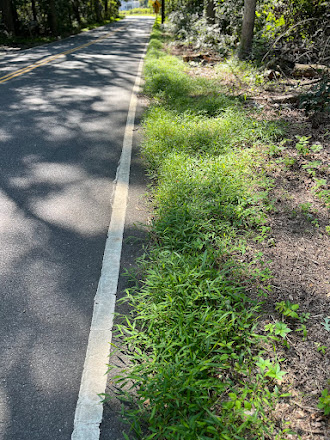For those fuzzy on identification, google lots of images, and look for the silver line running down the middle of the leaf. Stiltgrass can grow in the shade or sun, climb up to four feet, or thrive in a miniature state while ducking below your mower in the lawn. It's incredible survival skills include being incredibly inedible for wildlife. Stiltgrass gives nothing back to the habitats it increasingly dominates.
More on Stiltgrass, and a Success Story
Walking in the local woods, you've probably seen this kind of scene--what looks like a grassy meadow extending through the forest. In the filtered light of the understory, its simplicity and lushness may have some visual appeal. And yet, in some ways what you are looking at is the ecological equivalent of an urban food desert.
Stiltgrass is an introduced plant that could be called a pervasive invasive, able to thrive most anywhere and dominate whole landscapes. Its success has come in part through being inedible. As wildlife selectively eat native vegetation, the stiltgrass expands, preventing the native plants from rebounding.Unlike another nonnative annual weed that can look similar, crabgrass, stiltgrass becomes ubiquitous because it can thrive in sun or shade. That means the stiltgrass invading your lawn and flower beds can continue spreading ad nauseum into the nearby forest, or vice versa.
Though stiltgrass has covered large areas of woodland in the eastern U.S., we have found it worthwhile and even satisfying to counter its relentless incursions. Today in the Barden at Herrontown Woods, some volunteers pulled it out of a patch of native jewelweed along the edge of the parking lot.
Nearby, on land where we have largely eliminated a massive clone of wisteria, stiltgrass was starting to move into the void. If nothing were done, this open woodland would have become a pasture of stiltgrass. But we have acted early enough to be able to remove all of this year's stiltgrass, dramatically reducing the seeds available for next year's crop. This photo shows the last patch before we pulled it.
Interestingly, there are native grasses that look a little like stiltgrass, the main one being Virginia cutgrass (white grass), Leersia virginica. It has longer, narrower leaves that lack the silver stripe down the middle. As is a common ecological refrain, the native grasses "play well with others," not forming stiltgrass's massive, exclusionary stands. Some smartweeds like Lady's Thumb can also bear a resemblance.
We used to call it bamboo grass--something in the shape of the leaves is reminiscent. The stiltgrass name refers to its angular growth, with each segment supporting the next as it climbs up and over fallen logs and other plants. Packing grass is another common name, referring to how it was once used to pack porcelain for shipment. That's probably how it first reached the U.S., in packing crates sent to Tennessee.
Stiltgrass tends to establish itself along roadsides. Here it is growing in a green ribbon along Herrontown Road. Trails, too, provide an avenue for extending its reach, its tiny seeds carried on boots or the hooves of deer.
When I first encountered it, growing on the bank of Ellerbe Creek in Durham, NC, I thought it graceful. Then came Hurricane Fran, bringing floods and fallen trees. In the aftermath of that massive disturbance, stiltgrass exploded in the landscape, expanding and ultimately choking forests with its vast, dense stands. New Jersey proved no different.
Though stiltgrass has covered large areas of woodland in the eastern U.S., we have found it worthwhile and even satisfying to counter its relentless incursions. Today in the Barden at Herrontown Woods, some volunteers pulled it out of a patch of native jewelweed along the edge of the parking lot.






No comments:
Post a Comment